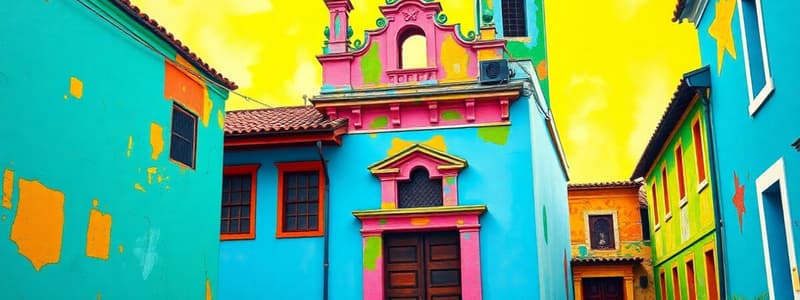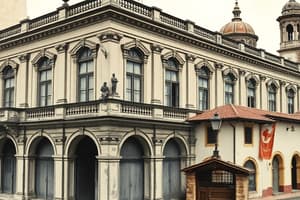Podcast
Questions and Answers
What is the primary architectural style of the Bauang Church?
What is the primary architectural style of the Bauang Church?
- Quasi-classic style (correct)
- Baroque style
- Gothic style
- Neo-classical style
How are the edges of the second story treated differently from the third story?
How are the edges of the second story treated differently from the third story?
- They use volutes.
- They incorporate a curved pediment.
- They are adorned with floral patterns.
- They feature stylized acanthus. (correct)
What feature is present on each side of the main portal of Bauang Church?
What feature is present on each side of the main portal of Bauang Church?
- Ornate pediments
- Large arches
- False doors (correct)
- Spiral columns
Which element caps the fourth story of the described structure?
Which element caps the fourth story of the described structure?
What distinguishes the height of the third story from the others?
What distinguishes the height of the third story from the others?
How many sections separate the two bands of the capitols in Bauang Church?
How many sections separate the two bands of the capitols in Bauang Church?
What type of pillars are repeated in the second story of the building?
What type of pillars are repeated in the second story of the building?
What materials were predominantly used for Filipino houses before the arrival of the Spaniards?
What materials were predominantly used for Filipino houses before the arrival of the Spaniards?
What architectural feature was common in pre-Spanish Filipino houses?
What architectural feature was common in pre-Spanish Filipino houses?
What major construction changes occurred during the Spanish period regarding materials?
What major construction changes occurred during the Spanish period regarding materials?
Which church is noted for having a true barrel vaulting structure?
Which church is noted for having a true barrel vaulting structure?
What feature characterized the early churches built in Intramuros?
What feature characterized the early churches built in Intramuros?
What construction was used to protect the Walled City during Governor-General Lavezares' time?
What construction was used to protect the Walled City during Governor-General Lavezares' time?
How many naves did the rebuilt Manila Cathedral have?
How many naves did the rebuilt Manila Cathedral have?
Which of the following churches is known for its 'quasi-classic architecture'?
Which of the following churches is known for its 'quasi-classic architecture'?
Filipino houses before the arrival of the Spaniards had a conical roof.
Filipino houses before the arrival of the Spaniards had a conical roof.
The San Agustin Church is known for its barrel vaulting that provides stability during earthquakes.
The San Agustin Church is known for its barrel vaulting that provides stability during earthquakes.
During the early Spanish regime, houses were primarily constructed with concrete and bricks.
During the early Spanish regime, houses were primarily constructed with concrete and bricks.
Intramuros features churches that are predominantly in barn style with high pitched roofs.
Intramuros features churches that are predominantly in barn style with high pitched roofs.
The Manila Cathedral was rebuilt after being destroyed by earthquakes in 1893.
The Manila Cathedral was rebuilt after being destroyed by earthquakes in 1893.
Flashcards
Pre-Spanish Filipino houses
Pre-Spanish Filipino houses
Made of light materials like bamboo, palms, vines, grass, and wood. Had pyramidal roofs, low walls, and floors raised above ground.
Spanish Period houses
Spanish Period houses
Initially used light materials, then transitioned to stronger ones like adobe. Houses were positioned away from town centers.
Early Spanish churches
Early Spanish churches
Built with massive stone and reinforced to be earthquake-resistant, like San Agustin Church.
Intramuros
Intramuros
Signup and view all the flashcards
Manila Cathedral
Manila Cathedral
Signup and view all the flashcards
San Agustin Church
San Agustin Church
Signup and view all the flashcards
Regional churches (barn style)
Regional churches (barn style)
Signup and view all the flashcards
Church in San Fernando
Church in San Fernando
Signup and view all the flashcards
Bauang Church Style
Bauang Church Style
Signup and view all the flashcards
Stories and Facades
Stories and Facades
Signup and view all the flashcards
Pillars
Pillars
Signup and view all the flashcards
Decorative Elements
Decorative Elements
Signup and view all the flashcards
Portal Decoration
Portal Decoration
Signup and view all the flashcards
Pillars' Capitals
Pillars' Capitals
Signup and view all the flashcards
False Doors
False Doors
Signup and view all the flashcards
Spanish Period Architecture: Changes
Spanish Period Architecture: Changes
Signup and view all the flashcards
Intramuros Fortifications
Intramuros Fortifications
Signup and view all the flashcards
San Agustin Church: Earthquake Resistance
San Agustin Church: Earthquake Resistance
Signup and view all the flashcards
Study Notes
Pre-Spanish Architecture
- Filipino houses used light materials like bamboo, palm, vines, grass, and wood.
- Roofs were pyramidal.
- Walls were low, and floors were raised above the ground.
Spanish Colonial Architecture
- Early Spanish houses used light materials but later used stronger materials like adobe.
- Churches were built on the east side of plazas, and government buildings (Casa Real/Casa Judicial) on the opposite side.
- Native houses were outside of town centers.
- Strong palisades (wooden fences) were built to protect cities, later replaced by stone walls.
- Intramuros walls were a significant engineering undertaking.
- Architectural attention was given to gates (e.g., Fort Santiago).
Church Architecture in the Spanish Period
- Early important buildings in Intramuros included San Agustin Church and Manila Cathedral.
- Early churches featured massiveness and stability.
- San Agustin Church's barrel vaulting allowed it to withstand earthquakes.
- Manila Cathedral (rebuilt after an earthquake) had 3 naves, a sacristy, an octagonal tower, and a Renaissance-style facade.
- Parish priests often managed provincial church construction.
- Many churches in the Philippines have a "barn-style" design with large dimensions, high pitched roofs producing a squat silhouette, and are similar in design.
- Some churches, like the one in San Fernando City, La Union, have facades that appear to be restored but show some original architectural treatment, with quasi-classical architecture (mixture of styles), and different stylistic elements for each story of the building.
- The Bauang Church in La Union also exemplifies quasi-classical style. Four composite pillars, false doors, and decorative elements are key features.
Studying That Suits You
Use AI to generate personalized quizzes and flashcards to suit your learning preferences.




